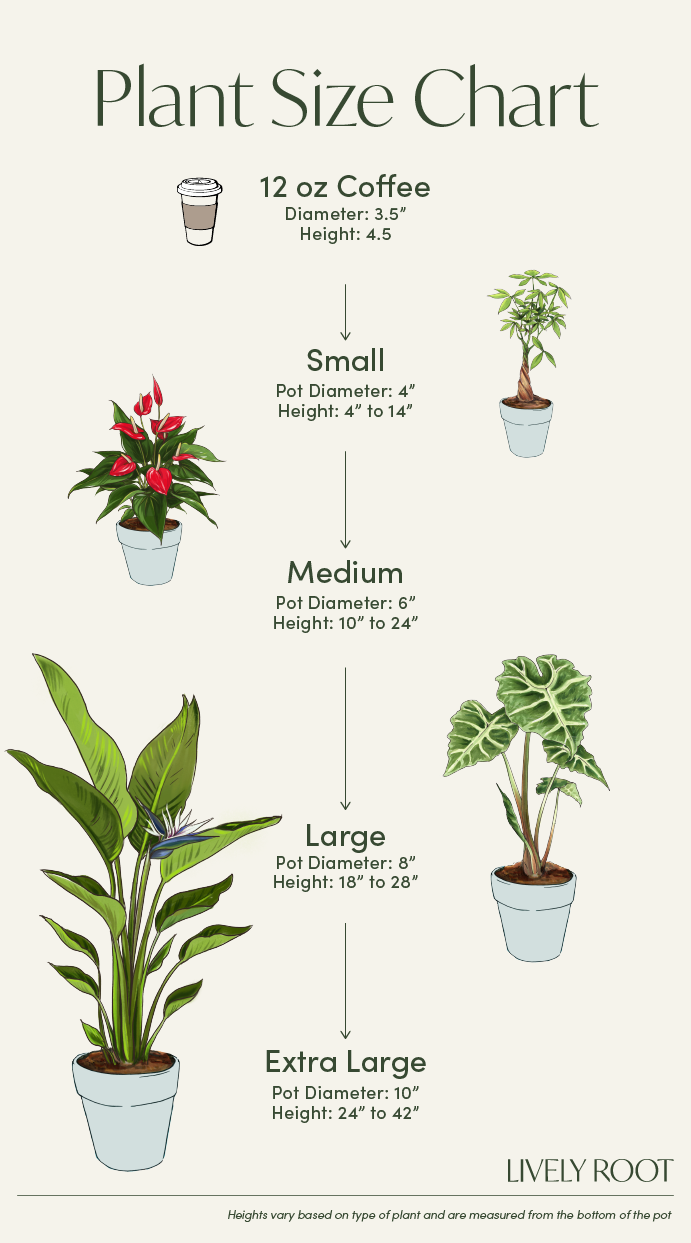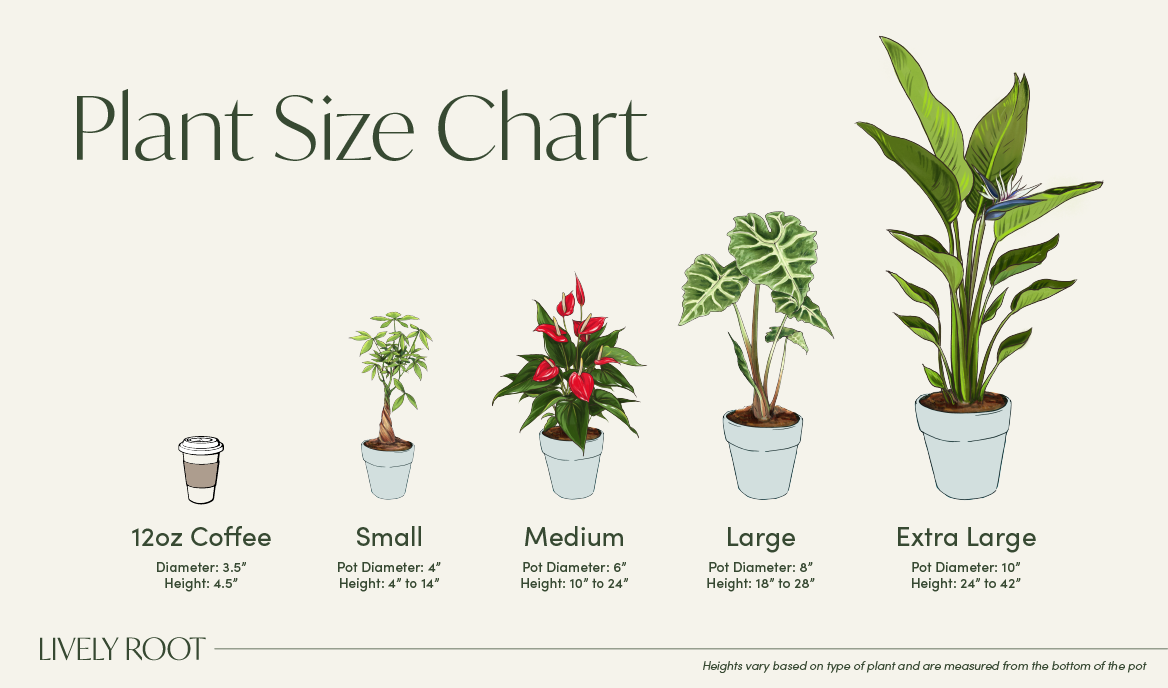

We can't promise that the Chinese money plant (Pilea Peperomioides) will bring you good fortune, but we can say they'll add instant style to any room. As well as being one of the most popular plants for Feng Shui, they are also famous with fans of Scandi design — They are Norway's favorite sill plant. Chinese money plants are also easy to care for and fun to grow. What's not to love?
Pilea Peperomioides Care Guide & Presentation (Chinese Money Tree)

Medium to bright indirect light. Never direct sunlight.
Let the soil dry between waterings.
No extra humidity required.
Keep this plant consistently in warm temperatures inside with nighttime temperatures decreasing to only 60°F-70°F.
Outside: Grow in dappled shade in morning sun where nights are above 50°F.
Indoors: The Chinese Money Plant enjoys medium to bright, indirect light.
Water the Chinese Money Plant one day prior to fertilizing. Fertilize once a month by diluting a liquid fertilizer by half strength. Let the plant rest in the fall and winter.
When receiving the plant, do not repot immediately but wait at least 6-12 months or if the roots are beginning to get crowded and growing through the drainage holes.
Repot in the spring, using a 2" bigger pot to keep the roots drier. (Too big of a pot could cause the soil to dry slower, which is not helpful.) Use a well-draining indoor potting mix with perlite to help with drainage or a cacti and succulent mix.
Water your plant in the old pot before transferring over and let them sit an hour. Place a piece of screening at the bottom of the container over the drainage hole to secure the soil and allow it to drain. Add soil to the bottom to elevate the root ball. Lift the plant and release the roots against the existing planter. Use a clean knife or garden trowel to wedge between the pot and the soil to loosen.
Inspect the root ball. Notice if there are any dead or rotting roots and trim off with sterile pruners. If the plant is rootbound, cut through the roots to alleviate continued encircling.
Ensure the plant is sitting about 1" below the edge of the pot to avoid water spillage. Add more soil and backfill around the sides by tamping down. Fill up to the soil line but not over.
Water thoroughly, leaving the soil damp but not soggy. If settling occurs, add more soil.
To clean the leaves and alleviate dust particles, give it a shower from above. Fill a watering can with filtered, distilled or tap water that has been sitting for 24 hours. Place the plant in a sink and lightly wash the leaves with a shower spray end watering can.
In early spring, take a pilea cutting, use a sharp knife to cut off pinkish red baby offshoots from the main stem. Remove at least an inch of stalk under the soil leading to the main stem. Be careful not to catch the knife of the healthy leaves on the mother plant.
If there is no root ball, remove all the soil and place in a vase with water to root. Change the water each week with filtered, bottled or tap water that has been sitting at least 24 hours.
If there is a root ball, then separate the mother plant from the babies and pot up. Follow the instructions below.*
After 3-4 weeks, check to make sure the stem has well formed roots. If so, it's time to plant.
*Fill a small container with drainage holes (too large of a container for the cutting will make it difficult to regulate watering needs) using indoor well-draining potting mix such as cacti and succulent mix.
Mix a little rooting hormone into the soil. Poke a hole in the soil with a pencil. Then, place the cutting in the hole and tamp the soil down around it.
Water the plant and keep them in medium to bright indirect sunlight. After 4-6 weeks, the roots should be established.
Chinese Money Plant: Overview
The Chinese Money Plant, scientifically known as Pilea peperomioides, is a charming houseplant known for its coin-shaped leaves. This plant belongs to the Urticaceae family and originates from southwestern China. It thrives in moderate sunlight and is relatively easy to care for. It’s a popular choice for indoor decor, symbolizing good fortune and financial prosperity. Also, it’s worth noting that Chinese Money plants are safe for pets.
Chinese Money Plant: Benefits
- Chinese Money plants are known for their strong air-purifying properties, improving indoor air quality.
- In Feng Shui, they symbolize good luck and prosperity, making them popular choices for homes and home offices.
- Their unique coin-shaped leaves add aesthetic value to any indoor space, enhancing visual appeal.
- The Chinese Money plant is ideal for bedrooms, as it helps reduce stress levels and promote a calming environment.
Pilea Peperomioides: Alternative Names
- UFO Plant
- Missionary Plant
- Friendship Plant
- Coin Plant
- Pancake Plant
Pilea Peperomioides Care Guide
Chinese Money plants are relatively easy to care for, making them suitable for beginner and experienced plant owners. Here’s how to ensure your plant thrives:
Watering and Light
Chinese Money plants prefer moist soil but are susceptible to root rot if overwatered. Allow the soil to dry out slightly between waterings, and water thoroughly when needed. Place your Chinese Money plant in bright, indirect light. Avoid direct sunlight, as it can scorch the leaves.
Temperature and Humidity
These plants prefer temperatures between 65°F and 75°F (18°C to 24°C). Protect them from sudden drafts and temperature changes. They can tolerate average indoor humidity levels. However, they will appreciate occasional misting or a pebble tray to increase humidity.
Soil, Repotting, and Feeding
Repot your Chinese Money plant every 1-2 years or when the roots outgrow the pot. Choose a slightly larger pot with good drainage. Feed your Friendship plant with a balanced liquid fertilizer diluted to half-strength during the growing season (spring and summer).
Propagation, Pruning, and Cleaning
You can easily propagate your Chinese plant by dividing offsets or from leaf cuttings. Plant the cuttings in moist soil and keep them warm and humid until roots develop. Trim any yellow or brown leaves as they appear to maintain the plant’s appearance and health. Wipe the leaves with a damp cloth regularly to remove dust and keep them looking vibrant.
Common Issues
Overwatering can lead to root rot, while underwatering can cause wilting and browning of the leaves. Ensure proper drainage and adjust watering accordingly. Pests like spider mites and mealybugs can occasionally be a problem. Be sure to treat any infestations promptly with insecticidal soap.
Chinese Money Plant: Placement, Companion & Alternative Plants
When considering where to place your Chinese Money plant, consider its preferences for bright, indirect light. Also, its compact size makes it versatile for various spaces. Additionally, explore companion and alternative plants that complement your Money plant’s care needs and aesthetic appeal.
Best Locations & Uses
- Enhancing air quality in bedrooms while bringing a touch of greenery to your sleeping space
- A symbol of good fortune, making it an auspicious gift for housewarming, weddings, or other special occasions.
- Safe for homes with pets, providing a pet-friendly option for plant enthusiasts, allowing you to enjoy its beauty worry-free
- Thriving in warmer climates, it can flourish as a porch plant, adding charm to outdoor living spaces.
- It is ideal for beginners in gardening, as its low-maintenance requirements make it a perfect starter plant for those new to plant care
Companion Plants
Enhance your indoor greenery with these delightful companion plants that complement the Chinese Money plant:
- Spider Plant (Chlorophytum comosum): With its graceful arching leaves, the Spider Plant contrasts beautifully with the round foliage of the Chinese Money plant, creating a dynamic visual appeal.
- Calathea Zebrina: The compact and charming Calathea Zebrina is a rare prayer plant that adds a touch of variety to your plant collection with its striped green foilage, complementing your Chinese Money plant.
- Pothos Pearl Jade (Epipremnum aureum ‘Marble Queen’): Known for its lush trailing vines, the Pothos Pearl Jade adds a cascading element to your plant display.
Alternative Plants
Looking for alternatives to the Chinese Money tree plant? Here are three options available on Lively Root:
- Baby Rubber Plant (Peperomia obtusifolia): This Baby Rubber Plant boasts beautiful variegation and a compact shape, ideal for small spaces.
- Money Tree (Pachira aquatica): Commonly known as the Pachira plant or braided money tree, it’s a popular Feng Shui plant that brings good luck and fortune into your home.
- Peacock Plant (Calathea roseopicta): With its variegated green and yellow leaves on top and watermelon colors of dark red on the bottom, the Peacock Plant stands out in any space.
Chinese Money Plant: FAQs
Q: Where is the best place to put a Chinese Money plant?
A: Place your Chinese Money plant in the southeast area of your home or office to bring you good fortune. To ensure it receives indirect light, put it near an east-facing window.
Q: What is the spiritual benefit of the Chinese Money plant?
A: In Chinese culture, Pilea peperomioides attracts prosperity, wealth, and abundance. It's one of the well-known lucky plants that people love to grow.
Q: Can Chinese Money plant grow in water?
A: You can grow a Chinese Money plant in water only. Still, it will thrive better and establish itself if you eventually transplant it in soil as a potted plant.
Q: Can you hang a Chinese Money plant?
A: Yes, you can easily grow this popular green beauty in a hanging basket. A hanging Chinese Money plant looks great in the front porch or on a east-facing balcony.
Bring Luck Into Your Home or Office With a Chinese Money Plant
Ready to invite prosperity and good fortune into your life? Don’t miss out on bringing home a charming Chinese Money plant from Lively Root today!
















































































